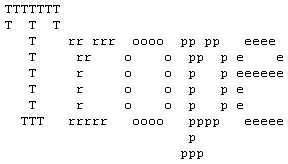ASCII Art

Using typed characters in a way that makes pictures. Usually done by treating the characters as pixels (best done with a monospaced font, and in a text file) and placing the characters in the appropriate spots line by line.
Some can even simulate different shades by using characters that take up different amounts of white space (hyphens and underscores take up little, and represent light shades, while pound and percent signs take up a lot, and represent dark shades).
Originates from the typewriter.
Often seen in online game walkthroughs, (like at GameFAQs). Message Boards and software crack teams will have this as well.
As with any art, the quality of a piece of ASCII art depends on the skill of the artist.
Compare the simplest form of this, the Emoticon.
We don't recommend you try to actually post any on this page, unless it's really narrow. Anything more than half again the width of this picture would be screwed up by different window sizes.
Anime and Manga
- Pani Poni Dash! sometimes replaced faces with ShiftJIS art.
Fan Works
- There was, at one point, an attempt to re-create Star Wars in ASCII art. It got about a third of the way through.
Film
- One character in You And Me And Everyone We Know makes ASCII art as a hobby. He makes a detailed image of a tiger.
Literature
- Informed Sources by Willard Bain, 1967, has some real, and some pseudo ASCII art. The whole book is in the form of teletype output (all Caps!) Near the end it lapses into ASCII art, showing a aerial dog-fight, but then uses characters which could NOT have been typed by a teletype terminal, as they are not aligned, and are partial overstrikes. Not an easy book to find though.
Music
- The back cover of Jaga Jazzist's album The Stix has the album credits formatted in the shape of a mountain range. (It's not true ASCII art, as it's not monospaced.)
Music Video
- This video for the Beck song "Black Tambourine" is ASCII-licious.
Video Games
- The credits of Portal. There are some in the source files that don't get used.
- Calling the BBS number gives ASCII art of what turned out to be official art from Portal 2.
- For awesome uses of ASCII art, there are modified versions of Quake and Unreal Tournament that render the graphics in ASCII.
- This is actually how Touhou's yukkuris were born; the ASCII Art the original poster had used made the girls' heads look deformed, and the rest went down in infamy.
- Dwarf Fortress, being inspired by Roguelikes, is made entirely in ASCII art just like them. You can download a graphics set, though.
Web Original
- Monospace is a Web Comic based on this concept.
Western Animation
- The Simpsons had a couch gag with ASCII art.
Other
- Taken to ridiculous extremes by the Japanese, who have thousands of characters in their fonts and aren't afraid to use them. 2Channel even has a whole board for it. Although technically speaking, this is Shift-JIS art, not ASCII art (look it up).
- LUEshi, an ASCII rendering of the Super Mario World box art, is the mascot of LUE, a board on GameFAQs.
- Densha Otoko, Train Man in English, has a lot of ASCII art. It is touted as an actual, somewhat edited, stream from 2ch. Worth reading. Note that the ASCII art requires that you have the Japanese fonts installed.
- ASCII Porn.
- A forum Troll has several stock Asciis including:
- The Captain Picard Face Palm
- Pedobear shows an interest in certain subjects.
- Dateline's Chris Hanson would like you to take a seat right over there...
- Dinosaur Comics' T. rex yelling
- Blaccuweather reporter Ollie Williams popping in for a quick update of his opinion of the topic..
- Admiral Ackbar may have a timely warning!
- The middle finger salute one.
- For April Fools' Day 2010, YouTube had a filter for at least half of the available videos named "TEXTp" which rendered different ASCII characters for different shades of a color. It was Too Cool to Live, unfortunately. VLC Media Player does have a similar effect, though.
- /人 ◕‿‿◕ 人\ - Kyubey's perpetual smile from Puella Magi Madoka Magica has hit memetic status. It's difficult to find a Madoka-related video on YouTube that doesn't have it in any of the comments.
- Some users of Facebook occasionally decorate their status messages with Unicode art: the Latin-1 range, stars, Japanese characters, box drawing characters, etc.
- It's also possible to make "Unicode graffiti" using certain combining characters that stack on top of each other. When enough are stacked, they will overflow and potentially litter the text that is above them.
- In the early '90s, Microsoft Works for DOS included a tutorial program that featured a goodly number of animated slides rendered entirely in 16-color ASCII art. Why? Because they could.